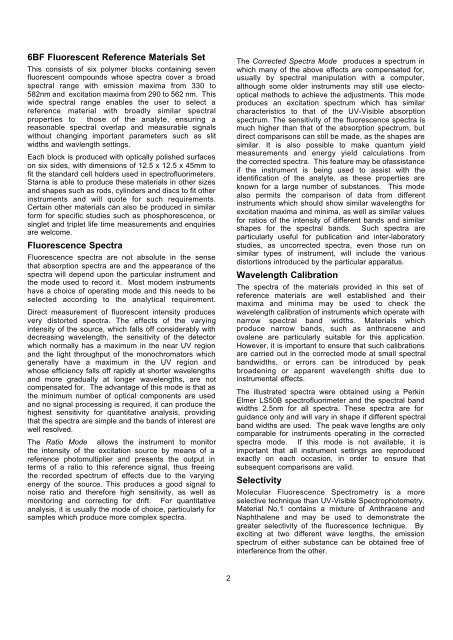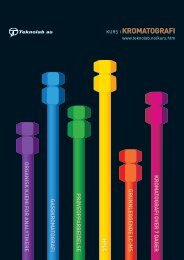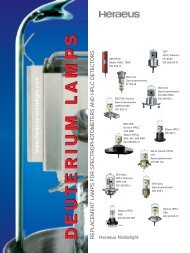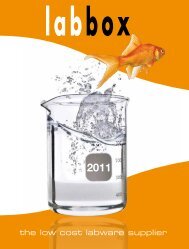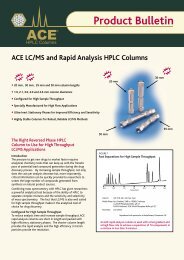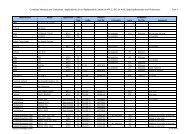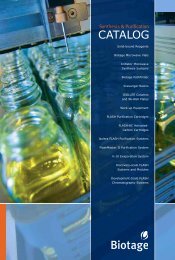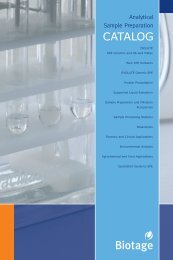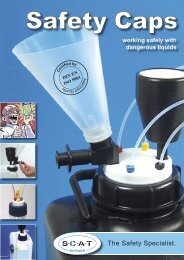Fluorescence Reference Materials Catalog - Teknolab AS
Fluorescence Reference Materials Catalog - Teknolab AS
Fluorescence Reference Materials Catalog - Teknolab AS
You also want an ePaper? Increase the reach of your titles
YUMPU automatically turns print PDFs into web optimized ePapers that Google loves.
6BF Fluorescent <strong>Reference</strong> <strong>Materials</strong> Set<br />
This consists of six polymer blocks containing seven<br />
fluorescent compounds whose spectra cover a broad<br />
spectral range with emission maxima from 330 to<br />
582nm and excitation maxima from 290 to 562 nm. This<br />
wide spectral range enables the user to select a<br />
reference material with broadly similar spectral<br />
properties to those of the analyte, ensuring a<br />
reasonable spectral overlap and measurable signals<br />
without changing important parameters such as slit<br />
widths and wavlength settings.<br />
Each block is produced with optically polished surfaces<br />
on six sides, with dimensions of 12.5 x 12.5 x 45mm to<br />
fit the standard cell holders used in spectrofluorimeters.<br />
Starna is able to produce these materials in other sizes<br />
and shapes such as rods, cylinders and discs to fit other<br />
instruments and will quote for such requirements.<br />
Certain other materials can also be produced in similar<br />
form for specific studies such as phosphorescence, or<br />
singlet and triplet life time measurements and enquiries<br />
are welcome.<br />
<strong>Fluorescence</strong> Spectra<br />
<strong>Fluorescence</strong> spectra are not absolute in the sense<br />
that absorption spectra are and the appearance of the<br />
spectra will depend upon the particular instrument and<br />
the mode used to record it. Most modern instruments<br />
have a choice of operating mode and this needs to be<br />
selected according to the analytical requirement.<br />
Direct measurement of fluorescent intensity produces<br />
very distorted spectra. The effects of the varying<br />
intensity of the source, which falls off considerably with<br />
decreasing wavelength, the sensitivity of the detector<br />
which normally has a maximum in the near UV region<br />
and the light throughput of the monochromators which<br />
generally have a maximum in the UV region and<br />
whose efficiency falls off rapidly at shorter wavelengths<br />
and more gradually at longer wavelengths, are not<br />
compensated for. The advantage of this mode is that as<br />
the minimum number of optical components are used<br />
and no signal processing is required, it can produce the<br />
highest sensitivity for quantitative analysis, providing<br />
that the spectra are simple and the bands of interest are<br />
well resolved.<br />
The Ratio Mode allows the instrument to monitor<br />
the intensity of the excitation source by means of a<br />
reference photomultiplier and presents the output in<br />
terms of a ratio to this reference signal, thus freeing<br />
the recorded spectrum of effects due to the varying<br />
energy of the source. This produces a good signal to<br />
noise ratio and therefore high sensitivity, as well as<br />
monitoring and correcting for drift. For quantitative<br />
analysis, it is usually the mode of choice, particularly for<br />
samples which produce more complex spectra.<br />
The Corrected Spectra Mode produces a spectrum in<br />
which many of the above effects are compensated for,<br />
usually by spectral manipulation with a computer,<br />
although some older instruments may still use electooptical<br />
methods to achieve the adjustments. This mode<br />
produces an excitation spectrum which has similar<br />
characteristics to that of the UV-Visible absorption<br />
spectrum. The sensitivity of the fluorescence spectra is<br />
much higher than that of the absorption spectrum, but<br />
direct comparisons can still be made, as the shapes are<br />
similar. It is also possible to make quantum yield<br />
measurements and energy yield calculations from<br />
the corrected spectra. This feature may be ofassistance<br />
if the instrument is being used to assist with the<br />
identification of the analyte, as these properties are<br />
known for a large number of substances. This mode<br />
also permits the comparison of data from different<br />
instruments which should show similar wavelengths for<br />
excitation maxima and minima, as well as similar values<br />
for ratios of the intensity of different bands and similar<br />
shapes for the spectral bands. Such spectra are<br />
particularly useful for publication and inter-laboratory<br />
studies, as uncorrected spectra, even those run on<br />
similar types of instrument, will include the various<br />
distortions introduced by the particular apparatus.<br />
Wavelength Calibration<br />
The spectra of the materials provided in this set of<br />
reference materials are well established and their<br />
maxima and minima may be used to check the<br />
wavelength calibration of instruments which operate with<br />
narrow spectral band widths. <strong>Materials</strong> which<br />
produce narrow bands, such as anthracene and<br />
ovalene are particularly suitable for this application.<br />
However, it is important to ensure that such calibrations<br />
are carried out in the corrected mode at small spectral<br />
bandwidths, or errors can be introduced by peak<br />
broadening or apparent wavelength shifts due to<br />
instrumental effects.<br />
The illustrated spectra were obtained using a Perkin<br />
Elmer LS50B spectrofluorimeter and the spectral band<br />
widths 2.5nm for all spectra. These spectra are for<br />
guidance only and will vary in shape if different spectral<br />
band widths are used. The peak wave lengths are only<br />
comparable for instruments operating in the corrected<br />
spectra mode. If this mode is not available, it is<br />
important that all instrument settings are reproduced<br />
exactly on each occasion, in order to ensure that<br />
subsequent comparisons are valid.<br />
Selectivity<br />
Molecular <strong>Fluorescence</strong> Spectrometry is a more<br />
selective technique than UV-Visible Spectrophotometry.<br />
Material No.1 contains a mixture of Anthracene and<br />
Naphthalene and may be used to demonstrate the<br />
greater selectivity of the fluorescence technique. By<br />
exciting at two different wave lengths, the emission<br />
spectrum of either substance can be obtained free of<br />
interference from the other.<br />
2


